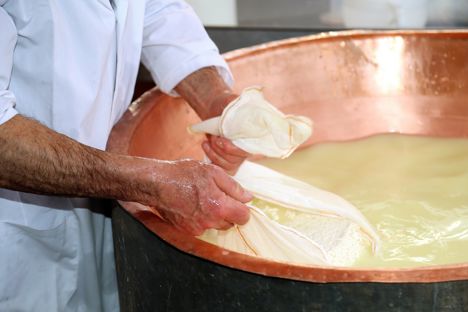
Old and new: cheesemaking through the ages
Nancy Anne Harbord takes a look at how technology has helped modern cheesemakers achieve consistently good results without having to sacrifice the artisanal, traditional methods of their ancestors.
Old and new: cheesemaking through the ages
Nancy Anne Harbord takes a look at how technology has helped modern cheesemakers achieve consistently good results without having to sacrifice the artisanal, traditional methods of their ancestors.
Cheesemaking, in some form or another, has a history stretching back at least 5,000 years. This is characteristic of the very oldest methods we turned to for producing and preserving food – concentration, fermentation and salting. Then, as now, the production of cheese enabled the nutritional and economic value of milk to be preserved and gave humans more choice over exactly when and how they consumed their food.
Traditional cheeses were produced in Britain by monasteries, farms and village co-operatives, and by the early eighteenth century the nine key territorial cheeses – cheddar, Cheshire, Lancashire, double Gloucester, red Leicester, Stilton, Wensleydale, Caerphilly and Sage Derby – were well established. However, industrialisation and urbanisation came earlier and more comprehensively to Britain, more so than to any other European country, and by the end of the Second World War traditional cheesemaking in Britain had effectively ended.
The vast majority of today’s cheese production is heavily industrialised, with many factories using computer-aided production in an effort to turn out a standardised product. Milk is pasteurised to remove wild, unpredictable bacteria and industrial starters are used in their place. Where calf rennet was once the primary choice for curdling the milk, today cheaper, non-animal coagulants are typically used in such large-scale operations.
The development and application of scientific method has also been a significant change for the manufacture of cheese, from the introduction of pasteurisation in the nineteenth century to the complex systems of milk analysis that are available today. In an effort to understand the factors that informed Stilton cheese production, for example, the cheese’s entire microbiological population was catalogued using DNA profiling, while the flavour profiles of the rind, blue and white parts were established using something called ‘gas chromatography-mass spectrometry’. These advanced methods helped identify particular yeasts that were causing batches to spoil and it is by understanding these organisms and the effects they have on the cheese that large scale producers have better control over the final result. Cheese, even industrial cheese, is still a living product.
Industrial meets artisanal
Although it is more science than craft now in these factories, a human element does remain. Even a company such as Dairy Crest, producer of the most popular cheddar in the UK, has human grading at the core of its quality control. Mark Pitts-Tucker, Dairy Crest’s head cheese grader, tastes up to 700 samples a week, checking each cheese for texture, flavour and keeping quality. Using the sensory skills he has developed over many years of working with cheese, he manages and organises Dairy Crest’s entire £200 million stock, culling poorer quality batches and putting aside those with superior keeping qualities. When asked if he thought this job could be replaced by computer, he told me: ‘Not a cat in hell’s chance. There’s always that artisan element. Some people like to break it down into an exact science, but there is an element of feel about the product as well. Feeding patterns on farms change, environmental conditions change – there are always subtle changes you have never seen before. Although consumers don’t always know it, there is a discerning human element in the middle of the cheese selection process.’
While there is no doubt that industrialised cheese makes up the bulk of production in the UK, the traditions of artisan cheese still continue on a small scale. These handmade cheeses are produced with the expectation that each batch will differ, with the seasons, the animal’s feed, the environmental conditions – and this difference is celebrated rather than avoided. While these practices have remained largely consistent in continental Europe, in the UK they have had to be revived after dying out completely. Today’s British artisans turn to historical texts and look to countries such as France, Italy and Portugal for inspiration.
Many traditional cheeses are still made in the same way as they have always been, but certain processes have changed. Steam has now replaced the fire that once heated milk and the introduction of milk analysis has demystified certain microbiological factors. Some – but certainly not all – of the backbreaking labour has been mitigated by recent technologies. Yet despite these innovations, cheese remains an artisan product, with the producer’s understanding of the milk, of the cheese’s production processes and of the surrounding environment informing the many decisions that are made daily – just as it would have done many hundreds of years ago. The hand-crafted element is still there too, with some traditional, artisan cheeses requiring the input of more than twice as many individuals than an industrial operation on a similar scale.
There are still enormous parallels between the cheesemaking of yesterday and the cheesemaking of today, even cheeses produced industrially or on a large scale. Milk is still curdled, drained, pressed and salted. The human senses of sight, smell, touch and taste are still key. And the end result still tastes great with a hunk of crusty bread.


